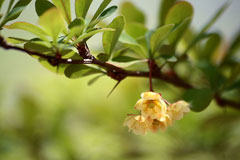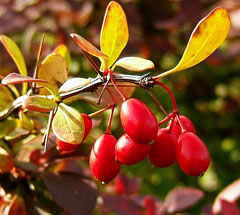 |
|
http://commons.wikimedia.org/wiki/User:Ragesoss |
 |
| http://commons.wikimedia.org/wiki/User:Wildfeuer |
Translate this page:
Summary
Bloom Color: White, Yellow.
Main Bloom Time: Early spring, Late spring, Mid spring. Form: Rounded. Barberries are dense, neat-growing, medium to large deciduous and evergreen shrubs. Native species exist in many areas, including Europe and North America. Deciduous forms often have spectacular autumn leaf colour and berries. Barberries will grow in sun or light shade but will fruit better in full sun and not flower in deep shade. Ornamental leaves, yellow flowers, and attractive berries make them popular garden plants. The dense and spiny growth habit makes them excellent hedges and barriers and shelter for wildlife. Many species have pleasant edible fruit that is eaten raw or cooked. Berberries do not do well in waterlogged soil and may need help in arid conditions. Some become invasive when planted outside of their native ranges, and many species are resistant to deer predation.
Physical Characteristics

 Berberis thunbergii is a deciduous Shrub growing to 2 m (6ft) by 3 m (9ft) at a medium rate.
Berberis thunbergii is a deciduous Shrub growing to 2 m (6ft) by 3 m (9ft) at a medium rate.
See above for USDA hardiness. It is hardy to UK zone 4 and is not frost tender. It is in flower in May. The species is hermaphrodite (has both male and female organs) and is pollinated by Insects. The plant is self-fertile.
It is noted for attracting wildlife.
Suitable for: light (sandy), medium (loamy) and heavy (clay) soils and can grow in heavy clay and nutritionally poor soils. Suitable pH: mildly acid and neutral soils. It can grow in semi-shade (light woodland) or no shade. It prefers dry or moist soil.
UK Hardiness Map
US Hardiness Map
Synonyms
Plant Habitats
Woodland Garden Dappled Shade; Shady Edge; Ground Cover; Hedge;
Edible Uses
Edible Parts: Fruit Leaves
Edible Uses:
Fruit - raw or cooked[105, 177]. Dry with a very poor flavour[K]. The fruits are about 8mm long[200]. Leaves - cooked.
References More on Edible Uses
Medicinal Uses
Plants For A Future can not take any responsibility for any adverse effects from the use of plants. Always seek advice from a professional before using a plant medicinally.
Anthelmintic Antibacterial Antiseptic Cancer Dysentery Febrifuge
The root bark is anthelmintic, antiseptic and febrifuge[178]. Berberine, universally present in rhizomes of Berberis species, has marked antibacterial effects. Since it is not appreciably absorbed by the body, it is used orally in the treatment of various enteric infections, especially bacterial dysentery[218]. It should not be used with Glycyrrhiza species (Liquorice) because this nullifies the effects of the berberine[218]. Berberine has also shown antitumour activity[218].
References More on Medicinal Uses
The Bookshop: Edible Plant Books
Our Latest books on Perennial Plants For Food Forests and Permaculture Gardens in paperback or digital formats.

Edible Tropical Plants
Food Forest Plants for Hotter Conditions: 250+ Plants For Tropical Food Forests & Permaculture Gardens.
More

Edible Temperate Plants
Plants for Your Food Forest: 500 Plants for Temperate Food Forests & Permaculture Gardens.
More

More Books
PFAF have eight books available in paperback and digital formats. Browse the shop for more information.
Shop Now
Other Uses
Dye Hedge Hedge
Agroforestry uses: Barberry can be used as a hedge, providing dense foliage that offers shelter for wildlife. Additionally, its deep roots can help with soil stabilization.
Plants can be grown as a medium-size hedge[29]. They are very tolerant of trimming and have prickles, making them an effective barrier to larger creatures[K]. The cultivar 'Atropurpurea Nana' can be used for ground cover[208]. It makes a dense covering when planted 30cm apart each way[208]. A yellow dye is obtained from the root and branches[178]. An Ornamental plant. 1. Nectary - Flowers rich in nectar and pollen:
Yes – Barberry flowers are small but rich in nectar and pollen, attracting bees and other pollinators.
2. Wildlife - Food (Fruit, Seeds, Leaf litter, Shelter, Nesting, Roosting):
Yes – Barberry produces edible berries that are a food source for birds and other wildlife. The dense, thorny branches provide good shelter and protection for nesting and roosting birds.
3. Invertebrate Shelter (Overwintering sites, Leaf litter, Groundcover):
Yes – Barberry shrubs' dense structure and leaf litter can offer overwintering sites and shelter for invertebrates.
4. Pest Confuser (Smell):
No – Barberry is not known for emitting a smell that confuses pests.
Special Uses
Ground cover Hedge Hedge
References More on Other Uses
Cultivation details
Landscape Uses: Border, Erosion control, Foundation, Pest tolerant, Hedge, Massing, Rock garden, Standard, Superior hedge, Specimen, Woodland garden. Prefers a warm moist loamy soil but it is by no means fastidious, succeeding in thin, dry and shallow soils[11, 200]. Prefers a lime-free soil according to one report[182]. Grows well in heavy clay soils. Succeeds in full sun or light shade[11, 200]. Plants are hardy to about -25°c[184]. A commonly grown ornamental plant, there are many named varieties[182]. Plants can be pruned back quite severely, they resprout well from the base[200]. Unlike most other members of this genus, this plant does not usually hybridize with other species[67]. An alternate host of 'black-stem rust' of wheat so it has been extensively grubbed up from its habitats. This species is notably resistant to honey fungus[200]. Special Features:
Attractive foliage, Not North American native, Invasive, Inconspicuous flowers or blooms.
References Carbon Farming Information and Carbon Sequestration Information
Temperature Converter
Type a value in the Celsius field to convert the value to Fahrenheit:
Fahrenheit:
The PFAF Bookshop
Plants For A Future have a number of books available in paperback and digital form. Book titles include Edible Plants, Edible Perennials, Edible Trees,Edible Shrubs, Woodland Gardening, and Temperate Food Forest Plants. Our new book is Food Forest Plants For Hotter Conditions (Tropical and Sub-Tropical).
Shop Now
Plant Propagation
Seed - best sown as soon as it is ripe in a cold frame, when it should germinate in late winter or early spring[78]. Seed from over-ripe fruit will take longer to germinate[78], whilst stored seed may require cold stratification and should be sown in a cold frame as early in the year as possible[80]. The seedlings are subject to damping off, so should be kept well ventilated[113]. When the seedlings are large enough to handle, prick them out into individual pots and grow them on in a cold frame. If growth is sufficient, it can be possible to plant them out into their permanent positions in the autumn, but generally it is best to leave them in the cold frame for the winter and plant them out in late spring or early summer of the following year. Cuttings of half-ripe wood, July/August in a frame. Fairly easy[11]. Cuttings of mature wood of the current season's growth, preferably with a heel, October/November in a frame[78]. Fairly easy[11].
Other Names
If available other names are mentioned here
Japanese barberry. French: vinettier de thunberg.
Finland: Japaninhappomarja.
Germany: Japanischer Sauerdorn; Thunbergs Berberitze.
Italy: berberis.
Netherlands: Japanse berberis; zuurbes.
Poland: berberys thungerga.
Sweden: häckberberis; haeckberberis.
Native Range
TEMPERATE ASIA: Japan
Weed Potential
Right plant wrong place. We are currently updating this section.
Please note that a plant may be invasive in one area but may not in your area so it's worth checking.
Noxious Weed Information: US: Connecticut
(Japanese barberry):
Invasive, not banned.
Massachusetts
(Japanese barberry):
Prohibited.
Michigan
(Berberis):
Prohibited. A significant threat to natural areas due to its popularity as a landscape shrub, ability to tolerate full shade, and the dispersal of its prolific seeds by birds. B. thunbergii is shade tolerant and has invaded closed canopy forests, such as in parts of north-eastern USA [1d].
Conservation Status
IUCN Red List of Threatened Plants Status : This taxon has not yet been assessed.

Growth: S = slow M = medium F = fast. Soil: L = light (sandy) M = medium H = heavy (clay). pH: A = acid N = neutral B = basic (alkaline). Shade: F = full shade S = semi-shade N = no shade. Moisture: D = dry M = Moist We = wet Wa = water.
Now available:
Food Forest Plants for Mediterranean Conditions
350+ Perennial Plants For Mediterranean and Drier Food Forests and Permaculture Gardens.
[Paperback and eBook]
This is the third in Plants For A Future's series of plant guides for food forests tailored to
specific climate zones. Following volumes on temperate and tropical ecosystems, this book focuses
on species suited to Mediterranean conditions—regions with hot, dry summers and cool, wet winters,
often facing the added challenge of climate change.
Read More
Expert comment
Author
DC.
Botanical References
1158200
Links / References
For a list of references used on this page please go here
Readers comment
| Add a comment |
|
If you have important information about this plant that may help other users please add a comment or link below. Only comments or links that are felt to be directly relevant to a plant will be included. If you think a comment/link or information contained on this page is inaccurate or misleading we would welcome your feedback at [email protected]. If you have questions about a plant please use the Forum on this website as we do not have the resources to answer questions ourselves.
* Please note: the comments by website users are not necessarily those held by PFAF and may give misleading or inaccurate information.
To leave a comment please Register or login here All comments need to be approved so will not appear immediately.
|
Subject : Berberis thunbergii
|
|
|
|